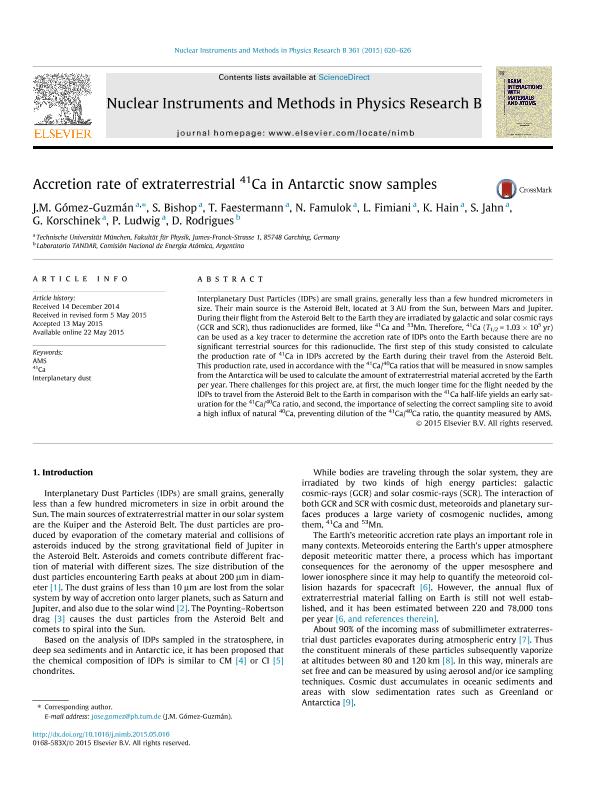Artículo
Accretion rate of extraterrestrial 41Ca in Antarctic snow samples
Gómez Guzmán, J. M.; Bishop, S.; Faestermann, T.; Famulok, N.; Fimiani, Leticia; Hain, K.; Jahn, S.; Korschinek, G.; Ludwig, P.; Rodrigues Ferreira Maltez, Dario Pablo

Fecha de publicación:
10/2015
Editorial:
Elsevier Science
Revista:
Beam Interactions with Materials and Atoms
ISSN:
0168-583X
Idioma:
Inglés
Tipo de recurso:
Artículo publicado
Clasificación temática:
Resumen
Interplanetary Dust Particles (IDPs) are small grains, generally less than a few hundred micrometers in size. Their main source is the Asteroid Belt, located at 3 AU from the Sun, between Mars and Jupiter. During their flight from the Asteroid Belt to the Earth they are irradiated by galactic and solar cosmic rays (GCR and SCR), thus radionuclides are formed, like 41Ca and 53Mn. Therefore, 41Ca (T1/2 = 1.03 × 105 yr) can be used as a key tracer to determine the accretion rate of IDPs onto the Earth because there are no significant terrestrial sources for this radionuclide. The first step of this study consisted to calculate the production rate of 41Ca in IDPs accreted by the Earth during their travel from the Asteroid Belt. This production rate, used in accordance with the 41Ca/40Ca ratios that will be measured in snow samples from the Antarctica will be used to calculate the amount of extraterrestrial material accreted by the Earth per year. There challenges for this project are, at first, the much longer time for the flight needed by the IDPs to travel from the Asteroid Belt to the Earth in comparison with the 41Ca half-life yields an early saturation for the 41Ca/40Ca ratio, and second, the importance of selecting the correct sampling site to avoid a high influx of natural 40Ca, preventing dilution of the 41Ca/40Ca ratio, the quantity measured by AMS.
Palabras clave:
41CA
,
AMS
,
INTERPLANETARY DUST
Archivos asociados
Licencia
Identificadores
Colecciones
Articulos(SEDE CENTRAL)
Articulos de SEDE CENTRAL
Articulos de SEDE CENTRAL
Citación
Gómez Guzmán, J. M.; Bishop, S.; Faestermann, T.; Famulok, N.; Fimiani, Leticia; et al.; Accretion rate of extraterrestrial 41Ca in Antarctic snow samples; Elsevier Science; Beam Interactions with Materials and Atoms; 361; 10-2015; 620-626
Compartir
Altmétricas



